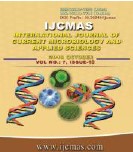


 National Academy of Agricultural Sciences (NAAS)
National Academy of Agricultural Sciences (NAAS)

|
PRINT ISSN : 2319-7692
Online ISSN : 2319-7706 Issues : 12 per year Publisher : Excellent Publishers Email : editorijcmas@gmail.com / submit@ijcmas.com Editor-in-chief: Dr.M.Prakash Index Copernicus ICV 2018: 95.39 NAAS RATING 2020: 5.38 |
Screened the all collected microalga samples from in and around the Western Ghats of Karnataka state for the bioethanol and biomass production. 62 terrestrial microalgae were collected from the fresh water bodies and only 5 samples used for bioethanol production on the basis of biochemical characteristics, were used for multiplication and fermentation study. Multiplication of algae was done by open ponds production system. Bioethanol production study was attempted by anaerobic fermentation using defatted algal residues. The hydrolyzed residue was used as substrate for fermentation using 5% of Saccharomyces cerevisiae inoculum. In fermentation setup biochemical components viz., percent alcohol, total soluble sugars, total reducing sugars, proteins, pH, organic acids, microbial load and brix were estimated and used for standardization of fermentation time. The maximum bioethanol (61.76±1.12%) was observed at 21st days after fermentation in Rhizoclonium hieroglyphicum and minimum (57.51±0.99) in the Spirogyra sp. Based on study conducted, it can be suggested that terrestrial microalgae can be used for bioethanol production by growing in polluted or waste water.
 |
 |
 |
 |
 |